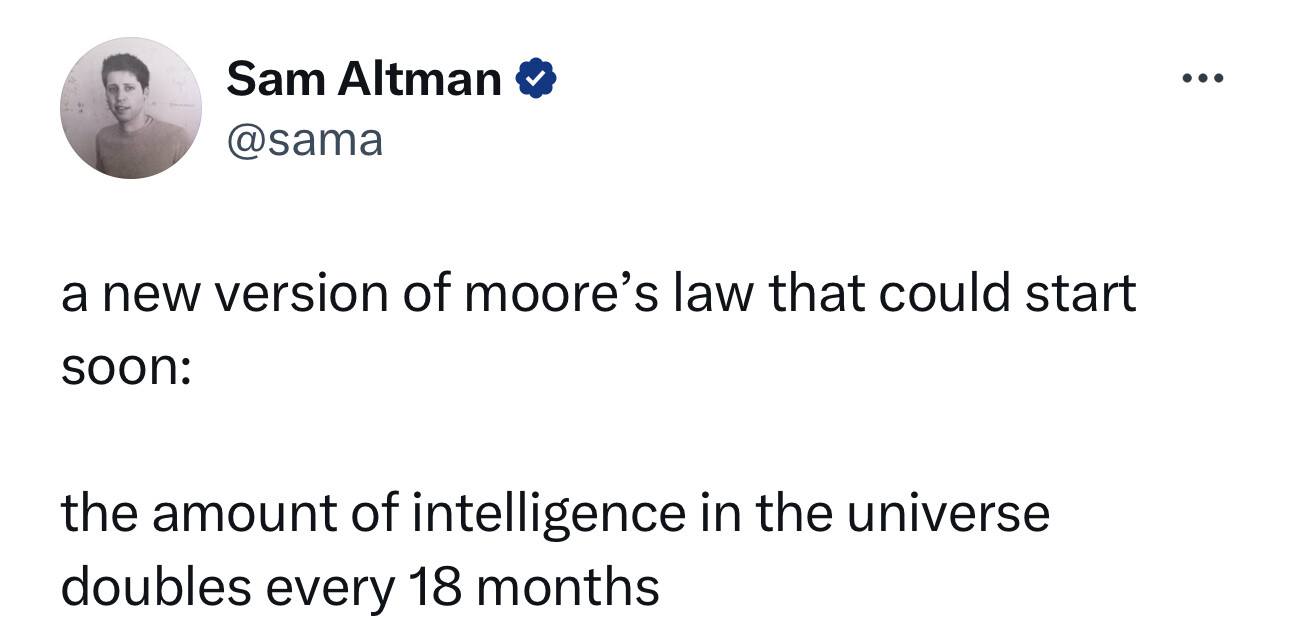The father of ChatGPT proposed a new Moore's Law: the number of universe intelligence doubles every 18 months
On February 26, local time, "Father of ChatGPT" and OpenAI CEO Sam Altman said on social media that a new Moore's Law may appear soon, that is, the number of intelligence in the universe doubles every 18 months. some. Some netizens directly called it "Altman's Law".
In 1965, Gordon Moore, who was an engineer at Fairchild Semiconductor and later founded Intel, proposed that the transistor density of semiconductor chips doubled every 18 months, known as Moore's Law, which was later corrected to within 24 months or two years. Double the transistor density and cut the cost in half.

Altman's tweet sparked widespread speculation. An AI scientist from Meta told The Paper that Altman's statement is too vague. What exactly does "intelligence" refer to? Does "universe" mean the universe? "His statement is not a serious statement, and his tweets are full of doubts about the meaning of his expression."
Under Altman’s tweet, the most praised comment came from the famous American computer scientist Grady Butch: “My God, what is he talking about.” The second answer came from the co-founder of OnePlus Technology Pei Yu, "It may be on the earth, but who knows who else is in the infinite universe."
Another AI "big bull" Gary Marcus, who often quarreled with Meta's chief AI scientist Yang Likun on social media, said bluntly: "It can be said that the new version of Moore's Law has begun: the amount of hype around AI doubles every 18 months. some."
Some netizens left a message saying that a quantitative measure is needed to make sense. The definition of "intelligence" was also mentioned, including IQ (intelligence quotient), EQ (emotional quotient), SQ (social quotient) and AQ (adversity quotient). Others claim that Altman was talking about "intelligence" and didn't limit growth to artificial intelligence or even software.
“He means AI will continue to get smarter, improving the intelligence of the entire universe,” said one netizen. Another wrote, “Just because AI makes us smarter doesn’t mean we Getting smarter. As technology advances, the need for emotional intelligence, meaning, and self-knowledge becomes ever more important. Can artificial intelligence help us in our quest for wisdom?"
So, what index should be used to evaluate the growth of the number of intelligence in the universe? According to the existing research, it can be speculated that the evaluation methods may include: computing power, academic publications, number of patents and data storage.
If the "Intelligence" mentioned by Altman is understood as computing power, Zhang Jiaxing, chair scientist of the Guangdong-Hong Kong-Macao Greater Bay Area Digital Economy Research Institute (IDEA), told The Paper (www.thepaper.cn), "Moore's Law has come to an end. At the end of the day, if AI computing power is required to continue to double every 18 months, it will inevitably require us to have some new creative thinking on computer architecture and computing power center construction.”
According to the 2022 State of Artificial Intelligence report, computing demands in machine learning are growing at an accelerated rate. According to the time when the amount of training calculations for each model doubles, three eras of machine learning are identified: the pre-deep learning era (before 2010, the training calculations doubled every 20 months), the deep learning era (2010-2015 Years, doubling every 6 months), and large-scale era (2016-present, 100-1000 times growth, then doubling every 10 months).
In the latest financial report conference, Nvidia CEO Huang Renxun said that Nvidia's GPU has increased the processing performance of AI by 1 million times in the past ten years. "Moore's Law, in its best days, can achieve a 100-fold increase in ten years. By proposing new processors, new systems, new interconnects, new frameworks and algorithms, and working with data scientists, AI researchers to develop new models, and across the span we've made large language models a million times faster."
In addition, the "2022 Stanford AI Index Report shows that" in the past ten years, the number of global AI papers published has doubled, from 162,444 in 2010 to 334,497, and it is increasing year by year. Papers in the field of pattern recognition and machine learning have doubled in just six years from 2015 to 2021. Globally, patent applications rose from 1 million in 1995 to 2 million in 2010, then 3 million in 2016.
Discussions about whether Moore's Law is still valid come up from time to time. On September 21, 2022, Huang Renxun said in an interview with The Paper that Moore's Law is over, and achieving twice the performance expectation at a similar cost is a thing of the past for the industry.
A week later, Intel CEO Pat Kissinger said at a company press conference that Moore's Law "is still valid." Intel is still actively trying to cram more transistors on a single chip. However, there is a limit to the size of the transistor, and when the transistor gets small enough, it runs into physical problems.
"The method of brute force plus transistors and the progress of Moore's Law have basically come to an end." Huang Renxun told investors in a later interview.
A netizen left a message under Altman's tweet: "This time we should hurry up, why is it 18 months?"